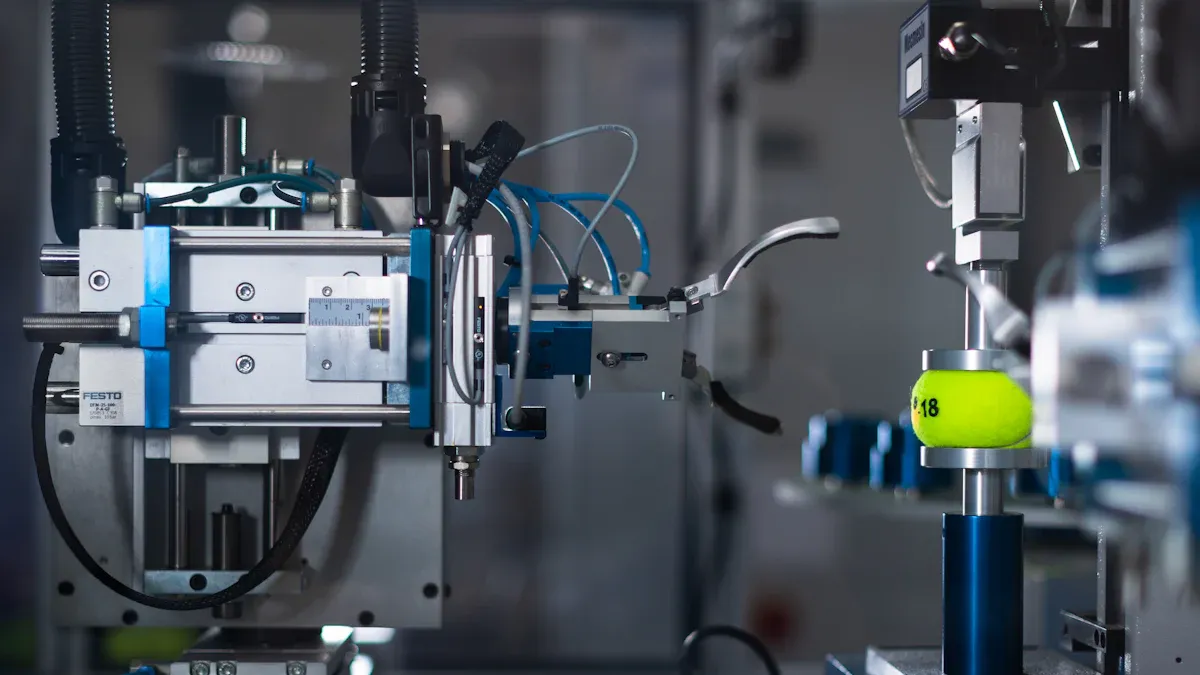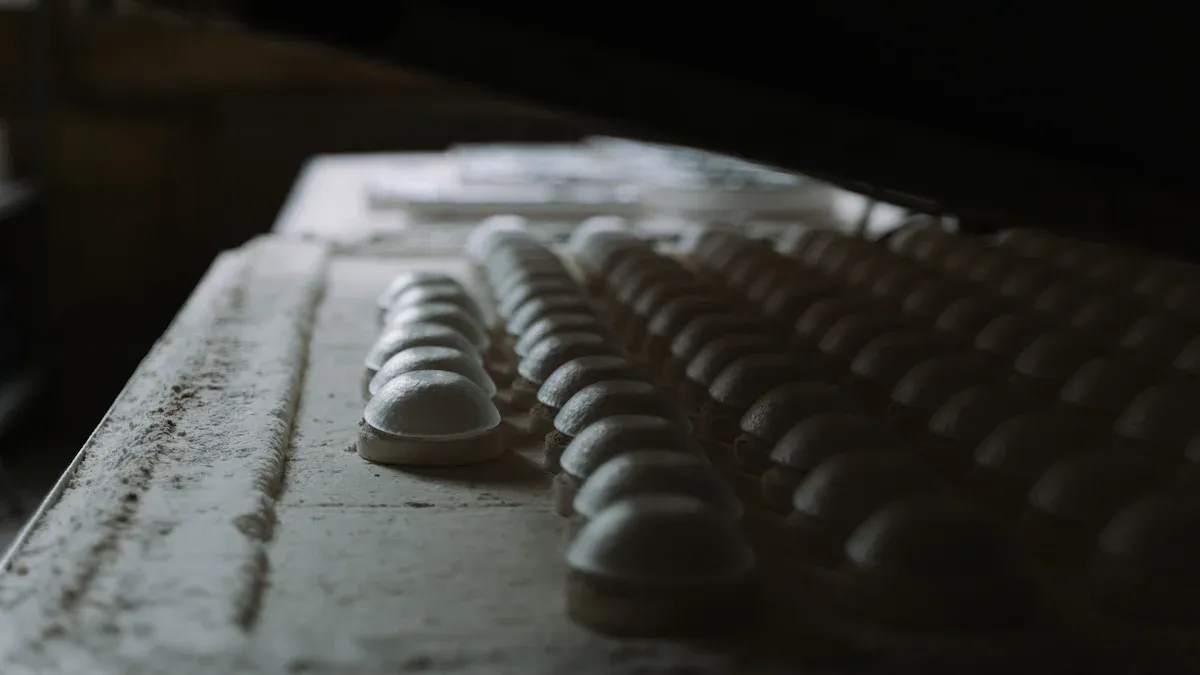
Gate placement strategies play a critical role in molding processes. By implementing effective gate placement strategies, you can achieve high-quality parts with fewer defects and reduced post-processing. Proper placement ensures smooth material flow, prevents common issues like shrinkage and air traps, and optimizes production efficiency. For instance, adjusting injection pressure by 80 MPa can improve fill time from 1.58 seconds to 1.22 seconds, reducing troubleshooting efforts. Additionally, accurate gate placement strategies minimize stress concentrations and cosmetic flaws, enhancing durability and appearance. Designers often select gates based on production goals to optimize flow and reduce costs, ensuring consistent filling and faster cycle times.

Uniform material flow is essential for producing high-quality molded parts. When the material flows evenly through the mold, it reduces the risk of defects like warping and shrinkage. Proper gate placement plays a key role in achieving this balance. For example, placing the gate centrally ensures the material spreads uniformly, minimizing stress and improving part strength. On the other hand, improper gate positioning can lead to uneven distribution, causing defects and reducing the overall quality of the product.
To illustrate, consider the following findings:
| Evidence Description | Key Findings |
|---|---|
| Central gate placement | Leads to balanced flow, reducing warpage and shrinkage. |
| Improper gate positioning | Causes uneven material distribution and defects. |
| Gate location away from thicker sections | Improves packing and reduces voids, enhancing weld line strength. |
By understanding how material flows within the mold, you can strategically place gates to enhance efficiency and ensure consistent results.
Air traps and weld lines are common issues in injection molding gate design. These defects occur when the material flow is disrupted, trapping air or creating weak points where two flow fronts meet. Strategic gate placement helps you avoid these problems. For instance, placing the gate near the thickest section of the part ensures complete filling and reduces the chance of air entrapment. Additionally, avoiding gate locations that force the material to flow around obstacles minimizes weld lines.
Proper gate placement strategies also improve weld line strength by ensuring the material flows smoothly and evenly. This coordination between gate location and mold design enhances part quality and reduces production challenges. By focusing on these factors, you can achieve better results and minimize defects in your molded parts.
Achieving even cavity filling is crucial for producing high-quality molded parts. When the material fills the mold cavities uniformly, it prevents defects like dimensional inconsistencies and weight variations. Optimizing the gate location ensures that the material flows evenly, reducing the risk of incomplete filling or overpacking in certain areas. For example, placing the gate at a central point or near thicker sections of the part promotes balanced filling.
Technologies like MeltFlipper and cavity pressure sensing are essential for achieving uniform filling across cavities, which enhances part quality, reduces cycle times, and minimizes dimensional and weight variations. The MeltFlipper technology helps in distributing hotter and cooler melt evenly among cavities, leading to lower overall injection pressure and improved cycle times. Additionally, the Priamus Fill system optimizes filling by ensuring all cavities experience the same holding pressure, resulting in consistent part weights and dimensions.
The benefits of optimized gate placement strategies extend beyond quality. They also improve production efficiency by reducing cycle times and minimizing material waste. By carefully selecting the gate location, you can achieve consistent results and streamline your injection molding gate process.
| Evidence Type | Description |
|---|---|
| Core Deflection Reduction | Core deflection is reduced by more than 70% with optimized gate placement. |
| Wall Thickness Adjustment | Wall thickness can be adjusted from 0.080 inches to 0.074 inches, leading to weight and cost reduction. |
| Filling Pressure Reduction | Optimized gate location reduces the required filling pressure, improving part quality and consistency. |
Stress and warping are common challenges in molded parts. These issues often arise due to uneven material flow or improper gate placement. By optimizing the gate location, you can minimize internal stress and reduce warpage, ensuring the final product meets quality standards. For instance, using multiple gates shortens the flow ratio and creates uniform melt density, which significantly reduces warpage.
| Gate Type | Effect on Flow Distance | Impact on Internal Stress | Warpage Reduction |
|---|---|---|---|
| Side Gate | Longer flow distance | Higher internal stress | Increased warpage |
| Point Gate | Shorter flow distance | Reduced internal stress | Decreased warpage |
| Multiple Gates | Shortens flow ratio | Uniform melt density | Significant reduction |
Proper gate placement also enhances the structural integrity of the part. Shorter flow distances reduce the likelihood of stress concentrations, while uniform material distribution prevents weak points. By focusing on the gate location, you can improve both the appearance and durability of your molded parts.

Strategic gate placement plays a vital role in reducing visible gate marks on molded parts. These marks often occur when the gate location is poorly chosen, leading to uneven material flow or excessive pressure during the injection process. By optimizing the gate design, you can ensure smoother material flow and minimize the appearance of these defects.
For instance, placing the gate in a less visible area of the part can help hide any residual marks. Additionally, using proper gate design, such as a fan or edge gate, can distribute the material more evenly, reducing the likelihood of flow lines or weld lines. The table below highlights how strategic gate placement can prevent common defects:
| Evidence | Description |
|---|---|
| Flow Lines | Strategic gate placement can prevent the occurrence of flow lines by optimizing the design of the mold for smoother flow. |
| Weld Lines | Improving mold design for uniform flow significantly reduces weld lines, enhancing the merging of molten plastic fronts. |
By focusing on the gate location and design, you can enhance the overall appearance of your molded parts while maintaining production efficiency.
Proper gate placement is essential for preventing aesthetic flaws and ensuring the structural integrity of molded parts. Sink marks, for example, often arise in areas with thicker cross sections due to improper gate location. To avoid this, you should position the gate near thicker sections and ensure the material flows from thicker to thinner areas. This approach not only improves the part's appearance but also enhances its strength.
Several factors influence the effectiveness of gate placement in injection molding gate processes:
By following these principles, you can reduce the risk of defects and improve the quality of your molded parts. Recommendations for wall thickness and material flow direction are also critical for achieving optimal results. When you prioritize strategic gate placement, you ensure that your parts meet both aesthetic and functional requirements.
Properly size gates to ensure optimal material flow and part quality. The size of the gate directly affects how the material flows into the mold. For shear-sensitive materials, a gate that is too small can cause burning or premature freeze-off. On the other hand, a gate that is too wide may slow the flow, leading to incomplete packing, especially in thin parts. You must consider the material's viscosity and the part's thickness when determining the gate size.
In multi-cavity molds, the flow rate decreases as the material splits among cavities. Adjusting the injection velocity and gate dimensions ensures consistent quality across all cavities. For example:
- A wider gate may be necessary for thicker parts to prevent voids.
- A smaller gate works better for thin-walled parts to maintain flow speed and avoid defects.
In a study on gate land effects, researchers found that shorter lands can increase gate-freeze time due to reduced heat transfer. Starting with a slightly longer gate land helps avoid processing issues and ensures better results.
By tailoring the gate size to the material properties and part requirements, you can enhance efficiency and reduce defects.
Different types of gates offer unique advantages depending on the application. Selecting the right gate design improves both the appearance and functionality of the molded part. For instance:
| Gate Type | Benefits |
|---|---|
| Edge Gate | Reduces visible gate marks and enhances surface quality. |
| Pin Gate | Eliminates gate marks, ideal for small, detailed components. |
| Tab Gate | Ensures uniform filling, reducing weld lines and improving strength. |
| Submarine Gate | Improves surface finish, perfect for parts requiring a flawless appearance. |
| Valve Gate | Provides precise control over material flow, ensuring smooth filling and minimal defects. |
For large parts, tab gates ensure even filling and reduce weld lines. Pin gates work well for intricate designs, while valve gates offer precise control for high-quality finishes. Proper gate selection based on shape and application ensures better results and minimizes post-processing.
By understanding the benefits of various gate shapes, you can refine your gate placement strategies and improve overall part quality.
Simplifying gate removal is essential for reducing production time and improving part quality. A well-thought-out gate design ensures that gates can be easily removed without damaging the molded part. For instance, using a submarine gate allows automatic removal during ejection, eliminating the need for manual trimming. This approach not only saves time but also ensures a cleaner finish on the part.
In multi-cavity molds, simplifying gate removal becomes even more critical. Poorly designed gates can lead to inconsistent results across cavities, increasing the need for post-processing. By focusing on gate design, you can achieve uniformity and reduce the likelihood of defects. For example, a tab gate provides a clean break point, making removal easier and minimizing visible marks.
Tip: Choose gate designs that align with your part's geometry and material properties. This ensures efficient removal and reduces the risk of damage during the process.
Strategic gate design minimizes the need for secondary operations, such as sanding or polishing. By placing gates in less visible areas, you can avoid aesthetic flaws that require additional finishing. Additionally, selecting the right gate type, like a valve gate, ensures precise material flow and reduces excess flash, which often necessitates trimming.
Optimizing gate design also enhances overall production efficiency. The table below highlights how thoughtful gate design reduces post-processing needs and improves outcomes:
| Evidence Description | Supporting Claim |
|---|---|
| Optimizing gate design can lead to reduced gate counts and improved algorithmic fidelity. | This supports the claim that better gate design enhances production efficiency by minimizing post-processing needs. |
| The design process focuses on gate fidelity and crosstalk mitigation to improve algorithm execution accuracy. | This indicates that a well-designed gate can reduce errors, thus enhancing overall efficiency. |
By reducing the need for secondary operations, you save time and resources while maintaining high-quality standards. This approach is particularly beneficial in multi-cavity molds, where consistent results across all cavities are crucial.
Note: Investing in precise gate design upfront can significantly lower long-term production costs and improve part quality.
Strategic gate placement is essential for achieving mold perfection. It improves tolerances, reduces defects, and enhances material flow. These benefits ensure consistent quality and minimize production challenges. For example, proper gate design ensures uniform material flow, reducing warpage and inconsistencies. The table below highlights the key advantages:
| Key Benefit | Description |
|---|---|
| Improved Tolerances | Strategic gate placement helps achieve tighter tolerances in molded parts. |
| Reduced Defects | Proper design minimizes defects during the injection molding process. |
| Enhanced Material Flow | Ensures uniform material flow, reducing the risk of warpage and inconsistencies. |
By understanding material flow, optimizing gate location, and tailoring gate design to your needs, you can enhance production efficiency and product quality. Apply these strategies to streamline your process and achieve better results.
The most important factor is ensuring uniform material flow. Proper gate placement reduces defects like warping and shrinkage, improving the quality of the molded part.
You should consider the part's geometry, material properties, and aesthetic requirements. For example, pin gates work well for small parts, while fan gates suit larger components.
Yes, improper placement can lead to defects, requiring more post-processing or rework. This increases material waste and extends production time.
Gate size controls material flow into the mold. A gate that is too small can cause defects like burning, while an oversized gate may lead to incomplete packing.
Strategic placement minimizes weld lines by ensuring smooth material flow. Placing gates near thicker sections reduces weak points where flow fronts meet.